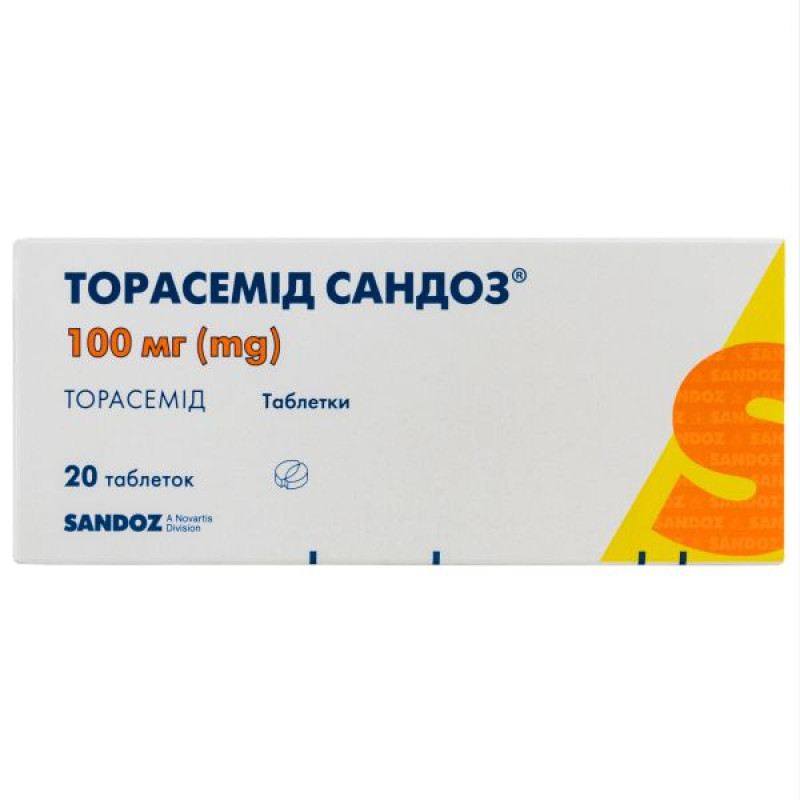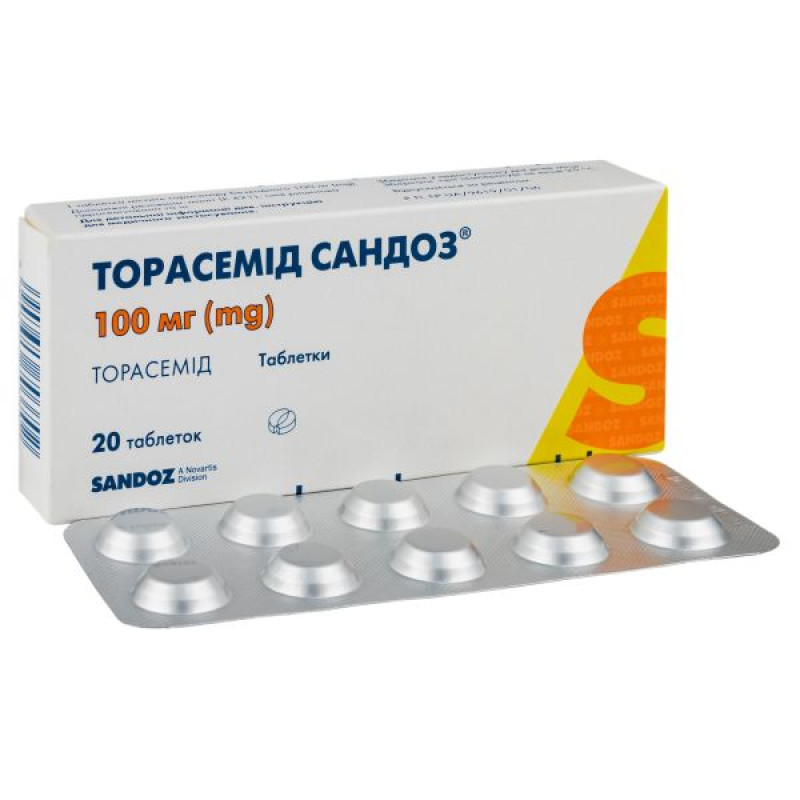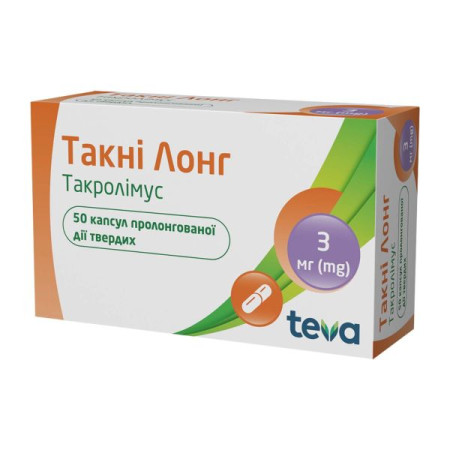Torasemide Sandoz tablets 100 mg No. 20

Instructions for use Torasemide Sandoz tablets 100 mg No. 20
Composition
active ingredient: torasemide anhydrous;
1 tablet contains torasemide anhydrous 2.5 mg or 5 mg, or 10 mg, or 20 mg, or 50 mg, or 100 mg, or 200 mg;
excipients:
tablets of 2.5 mg or 5 mg, or 10 mg, or 20 mg – lactose monohydrate, corn starch, colloidal anhydrous silicon dioxide, microcrystalline cellulose, magnesium stearate;
tablets of 50 mg or 100 mg, or 200 mg – colloidal anhydrous silicon dioxide, microcrystalline cellulose, magnesium stearate, mannitol (E 421), copovidone, crospovidone, hydrogenated castor oil.
Dosage form
Pills.
Main physicochemical properties:
2.5 mg and 50 mg tablets: round, white or almost white tablets without a score;
5 mg tablets: round tablets of white or almost white color with a score;
10 mg and 20 mg tablets: round tablets of white or almost white color with a cross-score;
100 mg tablets: round, white or almost white tablets with a score on both sides;
200 mg tablets: round, white or almost white tablets with a cross-score on both sides.
Pharmacotherapeutic group
Highly active diuretics. Simple sulfonamide preparations. ATX code C03C A04.
Pharmacological properties
Pharmacodynamics
Torsemide is a loop diuretic; at low doses used for antihypertensive treatment, it exhibits weak diuretic and saluretic effects. At higher doses, torasemide causes increased diuresis in a dose-dependent manner. Torsemide exhibits maximum diuretic activity 2-3 hours after oral administration.
Pharmacokinetics
After oral administration, torasemide is rapidly and almost completely absorbed; peak serum levels are reached 1-2 hours after administration. Systemic bioavailability is 80-90%. Binding of torasemide to plasma proteins is more than 99%, metabolites M1, M3 and M5 are 86%, 95% and 97%, respectively. The volume of distribution is 16 l. Torasemide is metabolized by oxidation and hydroxylation to form three metabolites: M1, M3 and M5. M5 is pharmacologically inactive, and metabolites M1 and M3 account for approximately 10% of the pharmacological action of the drug. The terminal half-life (t1/2) of torasemide and its metabolites is 3-4 hours in healthy subjects. Total clearance of torasemide is 40 ml/min, renal clearance is approximately 10 ml/min. About 80% of the dose is excreted as unchanged torasemide (24%) and its metabolites: M1 (12%), M3 (3%), M5 (41%). In renal failure, the half-life of torasemide does not change, and the half-life of metabolites M3 and M5 is prolonged. Torasemide and its metabolites are practically not removed by hemodialysis or hemofiltration. In patients with impaired liver function or heart failure, the half-lives of torasemide and metabolite M5 are slightly prolonged, however, cumulation of torasemide and its metabolites is unlikely.
Indication
2.5 mg or 5 mg tablets – arterial hypertension.
5 mg or 10 mg or 20 mg tablets – edema caused by heart failure.
Tablets of 50 mg or 100 mg, or 200 mg - edema, high blood pressure in severe renal failure (creatinine clearance less than 20 ml/min) in the presence of any residual diuresis (more than 200 ml in 24 hours), including in patients on hemodialysis.
Contraindication
Hypersensitivity to torasemide, to sulfonylurea derivatives or to any of the excipients. Renal failure with anuria, hepatic coma or precoma, arterial hypotension, arrhythmia. Hypovolemia, hyponatremia, hypokalemia. Significant urinary disorders, e.g. due to prostatic hypertrophy.
Interaction with other medicinal products and other types of interactions
When using torasemide with cardiac glycosides, the sensitivity of the heart muscle to these drugs may increase due to potassium or magnesium deficiency. When used simultaneously with mineralocorticoids, glucocorticoids, and laxatives, the risk of potassium deficiency increases.
Torasemide enhances the effect of other antihypertensive drugs, in particular angiotensin-converting enzyme (ACE) inhibitors. Concomitant use with ACE inhibitors may lead to severe hypotension. This can be prevented by reducing the initial dose of the ACE inhibitor or reducing the dose of torasemide 2-3 days before starting ACE inhibitors.
Torasemide may weaken the vasoconstrictor effect of adrenaline and noradrenaline.
Torasemide weakens the effect of antidiabetic drugs.
Torasemide, especially in high doses, may potentiate the nephrotoxic and ototoxic effects of aminoglycoside antibiotics (e.g. kanamycin, gentamicin, tobramycin), the toxic effects of platinum drugs and the nephrotoxic effects of cephalosporins.
Torasemide enhances the effect of theophylline and curare-like muscle relaxants.
Probenecid and non-steroidal anti-inflammatory drugs (e.g. indomethacin, propionic acid derivatives) weaken the diuretic and hypotensive effects of torasemide.
During therapy with salicylates in high doses, torasemide may enhance their toxic effect on the central nervous system.
When used simultaneously with cholestyramine, the absorption of torasemide may decrease, resulting in a weakening of its effect.
Application features
Before starting the drug, it is necessary to eliminate existing hypokalemia, hyponatremia, or hypovolemia.
During long-term treatment with torasemide, it is recommended to regularly monitor electrolyte balance (especially in patients who are simultaneously using digitalis glycosides, glucocorticosteroids, mineralocorticosteroids or laxatives), glucose, uric acid, creatinine and blood lipid levels.
Patients with a tendency to develop hyperuricemia and gout require special supervision.
Patients with overt or latent diabetes mellitus need to monitor carbohydrate metabolism.
Due to the lack of sufficient clinical experience, it is not recommended to prescribe torasemide in pathological changes in acid-base balance; in pathological changes in the blood picture, for example, thrombocytopenia or anemia in patients without renal failure; simultaneously with lithium, aminoglycosides, cephalosporins; in renal dysfunction caused by nephrotoxic substances; in children; in elderly patients (no dosage recommendations are available).
Torasemide should be used with extreme caution in patients with liver disease accompanied by cirrhosis and ascites, as sudden changes in water and electrolyte balance can lead to hepatic coma. Therapy with torasemide (as well as other diuretics) in this group of patients should be carried out in a hospital setting. To prevent hypokalemia and metabolic acidosis, the drug should be prescribed with aldosterone antagonists or drugs that promote potassium retention in the body.
After taking torasemide, ototoxicity (tinnitus and hearing loss) was observed, which were reversible, but a direct relationship with the use of the drug has not been established.
When prescribing diuretics, it is necessary to carefully monitor clinical symptoms of electrolyte imbalance, hypovolemia, extrarenal azotemia and other disorders, which may manifest as dry mouth, thirst, weakness, lethargy, drowsiness, agitation, muscle pain or cramps, myasthenia gravis, hypotension, oliguria, tachycardia, nausea, vomiting. Excessive diuresis can cause dehydration, lead to a decrease in circulating blood volume, thrombosis and embolism of blood vessels, especially in elderly patients.
Patients with water and electrolyte imbalance should discontinue use of the drug and resume therapy, starting with lower doses, after the undesirable effects have resolved.
When prescribing the drug, it is necessary to conduct regular laboratory monitoring of potassium and other electrolytes in the blood serum.
Information on dosing in patients with renal or hepatic impairment is limited. Patients with hepatic impairment should be administered the drug with caution as increased plasma concentrations of torasemide may occur.
Torasemid Sandoz 2.5 mg or 5 mg or 10 mg or 20 mg tablets contain lactose. If you have been told by your doctor that you have an intolerance to some sugars, contact your doctor before taking this medicine. Patients with rare hereditary problems of galactose intolerance, the Lapp lactase deficiency or glucose-galactose malabsorption should not take this medicine.
Torasemide SANDOZÒ tablets 50 mg or 100 mg or 200 mg contain hydrogenated castor oil, which may cause stomach upset and diarrhea.
Use during pregnancy or breastfeeding
There is no sufficient clinical experience with torasemide during pregnancy, so the drug can be prescribed during pregnancy only if the expected benefit to the mother outweighs the potential risk to the fetus (for vital indications and in the minimum possible effective dose). It is not known whether torasemide penetrates into breast milk, so breastfeeding should be discontinued during treatment with the drug.
The ability to influence the reaction speed when driving or working with other mechanisms
Until the individual response to torasemide is determined during treatment, caution should be exercised when driving vehicles and engaging in other potentially hazardous activities that require increased concentration and speed of psychomotor reactions.
Method of administration and doses
The tablets should be taken in the morning, without chewing, with a small amount of liquid.
The duration of treatment depends on the course of the disease; in case of heart failure, treatment should continue until the edema disappears.
Edema. Therapy should be initiated with a dose of 5 mg per day. This dose is usually considered maintenance. If a daily dose of 5 mg is insufficient, a daily dose of 10 mg should be used, which should be administered daily. Depending on the severity of the patient's condition, the daily dose may be gradually increased to 20 mg of torasemide (once a day).
Cirrhosis of the liver. The total initial dose is 5-10 mg 1 time per day when used together with aldosterone antagonists or potassium-sparing diuretics. In the absence of the necessary diuretic effect, the dose should be doubled (10-20 mg per day) until the desired effect is achieved.
In chronic renal failure, the dose is determined individually and depends on the degree of renal impairment. If the dose of 20 mg per day is insufficient, it can be increased to 50 mg of torasemide 1 time per day and, if necessary, gradually increased to the maximum dose of 200 mg 1 time per day. The maximum daily dose of 200 mg should be prescribed only to patients with severe renal impairment (creatinine clearance < 20 ml/min) (including during hemodialysis) in the presence of diuresis of at least 200 ml/24 h.
Patients with hepatic insufficiency. Treatment of such patients should be carried out with caution, as an increase in plasma concentrations of torasemide is possible.
Elderly patients: No special dose adjustment is required.
Children
The drug should not be used in children due to lack of data.
Overdose
Symptoms. Typical symptoms are unknown. In case of overdose, forced diuresis may occur with the risk of excessive loss of fluid and electrolytes. Drowsiness, confusion, hypotension, cardiovascular failure and gastrointestinal disorders may occur.
Treatment. There is no specific antidote. Depending on the symptoms of overdose, it is recommended to reduce the dose or cancel the drug. Measures are taken to restore water and electrolyte balance. Torasemide is not removed from the blood by hemodialysis. Treatment in case of hypovolemia: fluid volume replacement. Treatment in case of hypokalemia: administration of potassium preparations. Treatment of cardiovascular failure: sitting position of the patient and, if necessary, the appointment of symptomatic therapy.
Anaphylactic shock (immediate measures). At the first appearance of skin reactions (such as, for example, urticaria or redness of the skin), the patient's agitated state, headache, sweating, nausea, cyanosis, perform catheterization of the vein; place the patient in a horizontal position, ensure free air flow, and administer oxygen. If necessary, administer epinephrine, solutions that replace fluid volume, and glucocorticoid hormones.
Adverse reactions
Metabolism: increased metabolic alkalosis; muscle spasms (especially at the beginning of treatment); increased concentration of uric acid, glucose and lipids (cholesterol, triglycerides) in blood plasma; hypokalemia with concomitant diet low in potassium, with vomiting, diarrhea, after excessive use of laxatives, as well as in patients with chronic liver dysfunction. Depending on the dosage and duration of treatment, disturbances of water and electrolyte balance may develop, for example, hypovolemia, hypokalemia, hyponatremia. With significant losses of fluid and electrolytes due to increased urination, arterial hypotension, headache, asthenia, drowsiness may occur, especially at the beginning of treatment and in elderly patients.
From the cardiovascular system: thrombosis, arterial hypotension, cardiac and cerebral ischemia with the possible development of cardiac arrhythmias, angina pectoris, acute myocardial infarction, syncope.
On the part of the digestive tract: loss of appetite, nausea, vomiting, stomach pain, indigestion and diarrhea, constipation, flatulence, pancreatitis.
On the part of the urinary system: possible increase in serum creatinine and urea levels; in patients with urination disorders, for example, with prostatic hypertrophy, urinary retention and excessive bladder distension are possible; urge to urinate.
On the part of the hepatobiliary system: increased levels of some liver enzymes (γ-glutamyl transpeptidase) in blood plasma.
Blood and lymphatic system disorders: decreased platelets, erythrocytes and/or leukocytes.
Skin and subcutaneous tissue disorders: allergic reactions (e.g. pruritus, rash, exanthema, photosensitivity), severe skin reactions have been reported.
General disorders: headache, dizziness, confusion, increased fatigue, general weakness (especially at the beginning of treatment), dry mouth, paresthesia of the extremities, visual disturbances, tinnitus, hearing loss.
Expiration date
3 years.
Storage conditions
Store at a temperature not exceeding 25 °C.
Keep out of reach of children.
Packaging
10 tablets in a blister; 2 (10 ´ 2) or 10 (10 ´ 10) blisters in a cardboard box.
Vacation category
According to the recipe.
Producer
Salutas Pharma GmbH, Germany
Location
Otto-von-Guericke-Allee 1, 39179 Barleben, Germany.
or
Producer
Lek SA, Poland/ Lek SA, Poland
Poland, 95-010 Strykow, Podlipie Str., 16 /16, Podlipie Str., 95-010 Strykow, Poland
ul. Domaniewska, 50 C, Warszawa, 02-672, Poland.
There are no reviews for this product.
There are no reviews for this product, be the first to leave your review.
No questions about this product, be the first and ask your question.















